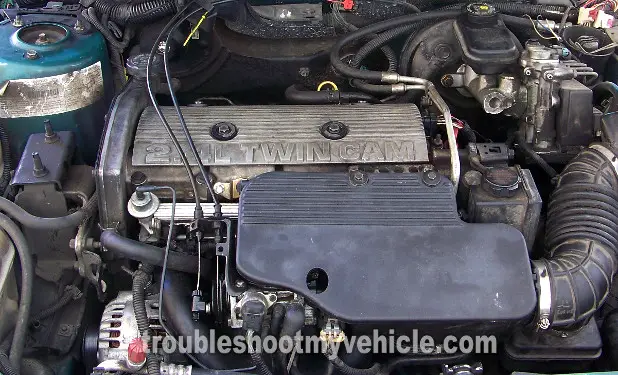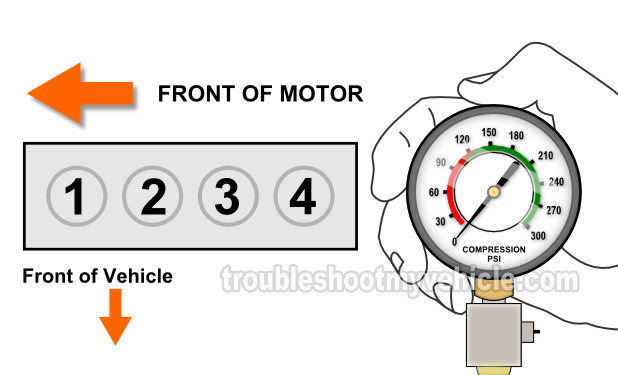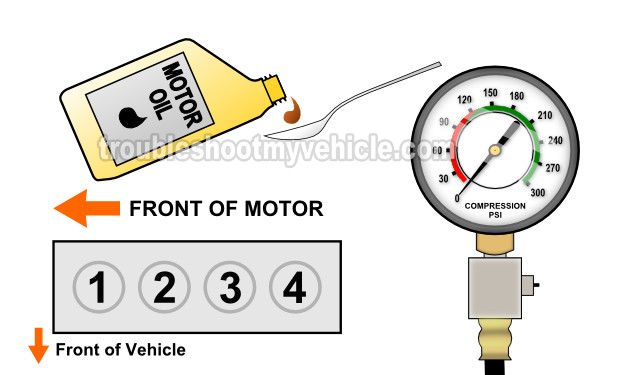
Troubleshooting a misfire (P0300, P0301, P0302, P0303, P0304) or rough idle condition on your Quad 4, whether it's a Chevy, or a Buick, or a Pontiac, or an Olds, can be a challenge that can have you pulling out your hair (I know from first hand experience).
There's a good chance you have already replace all of the common things that can go bad (like: spark plugs, plug boots, plastic coil cover, ignition coil pack, etc.) and the car is still running rough or with a misfire.
Well, an engine compression test will help you to either pin the blame on engine mechanical wear and tear or completely eliminate the engine's mechanical condition as the source of the issue. So whether you car Does Not Start or misfires, this article will take you step-by-step thru' the whole test.
Contents of this tutorial:
Tools You'll Need:
- Compression Gauge Tester.
- A helper
- Pen and Paper
Symptoms Of Low Or No Engine Compression
Engine compression problems will generally cause one of two types of problems.
1) Either the engine will not start or 2) the engine will start but it will run with a misfire.
By far the most common issue that you'll encounter, when the engine has a compression problem, is a cylinder misfire.
If your vehicle is OBD II equipped and the engine compression problem is causing a misfire, then you're going to see the check engine light lit up by one or more of the following trouble codes:
- P0300 Random Cylinder Misfire.
- P0301 Cylinder #1 Misfire.
- P0302 Cylinder #2 Misfire.
- P0303 Cylinder #3 Misfire.
- P0304 Cylinder #4 Misfire.
Generally, when an engine compression problem causes a rough idle, you're only going to feel the problem when you come to a stop light. But as soon as you accelerate the engine, the engine feels fine.
You're also gonna' see:
- Bad gas mileage.
- Engine pollutes more and it won't pass an emissions test.
If your 2.4L Quad 4 GM vehicle is NOT OBD II equipped, you won't have any codes lighting up the check engine light, but you'll definitely feel a rough idle condition.
OK, having covered the most common scenarios of low compression and no compression, let's get testing to see if this is the case on your vehicle.
Which Compression Tester Should I Buy?
There are lot of engine compression testers to choose from and many places to buy them. I'm gonna' make three recommendations to you:
Disclosure: As an Amazon Associate, I earn from qualifying purchases. If my tutorials help you, using these links is an easy way to support the site at no extra cost to you. Thank you!
TEST 1: 'Dry' Compression Test

Just a friendly reminder: You're gonna' be working around a cranking engine, so you have to be alert and think safety all of the time.
The compression test on your GM 2.4L Quad 4 engine can be done in under 20 minutes and at the end of the step-by-step testing instructions, I've included test interpretations so that you can interpret your test results.
NOTE: If your car starts and runs, it's important that the engine not be hot (technically: it should not be at normal operating temperature). So, if you've had the car running for an extended period of time, let the engine cool down for about an hour. If the engine is completely cold, start and run the engine for about 5 minutes. If your car doesn't start, then don't worry about the engine being warm or hot or cold.
OK, to get this party started, this is what you need to do:
- 1
Disable the fuel system. You can do this by either disconnecting all four fuel injectors or by removing the fuel pump relay.
This will prevent fuel from being injected into the engine while you do the compression test. - 2
Remove the aluminum cover that holds the plastic ignition coil cover (this is the cover that has the two ignition coils attached to it).
- 3
Remove all four spark plugs.
As you're taking them out, be careful and don't drop any of them on the floor, or you could cause the spark plug's ceramic insulator to break, and this will cause a misfire! - 4
Thread the engine compression gauge into the spark plug hole for the number 1 engine cylinder (this is the spark plug hole closest to the drive belt).
Hand tighten the compression gauge only! Do not use any type of tool to get it tight. - 5
When all is ready, have an assistant crank the engine while you observe the compression gauge.
- 6
Once the needle stops climbing on the gauge, have your helper stop cranking the engine.
- 7
Write the compression value down on a piece of paper. Include the number of the cylinder this reading belongs to.
- 8
Repeat steps 4 through 8 on the remaining cylinders.
Let's take a look at what your test results mean:
CASE 1: No compression in 2 or more cylinders. This test result tells you that the engine has serious internal problems.
The most common issues would be: Broken timing chain. Or a blown head gasket. Or the engine threw a rod.
CASE 2: Low compression in one or more cylinders. To a certain point, it's normal for the compression to vary a little between cylinders (as the engine accumulates thousands of miles).
But if these values vary too much, then you're gonna' have a bonafide misfire on your hands.
The next step is to do some math to find out if this low compression value is within a normal parameter or not. Go to: Interpreting Your Compression Test Results.
Interpreting Your Compression Test Results
As the engine ages and wears, the cylinder compression values differ from one another -especially if the engine has a lot of miles.
In most cases, and depending on how small or big the difference, nothing happens to engine performance.
When the difference is too big, you'll have a rough idle or a misfire condition on your hands.
To find out if the lower compression value is causing a problem, you need to find out if it's lower than 15% of the highest compression value you got.
You can do this (figuring out the 15%) in one of two ways: You can calculate this 15% difference with pen and paper or you can use my low compression calculator. You can find the low compression calculator here: Online Low Engine Compression Calculator (at: easyautodiagnostics.com).
If you want to manually calculate the 15% difference, here's what you'll need to do:
- STEP 1: Multiply the highest compression value by 0.15 (this is the decimal value of 15%).
- STEP 2: Round the result to the nearest one (for example: 25.6 would become 26).
- STEP 3: Subtract the result (the number that was rounded) from the highest compression value.
- ANSWER: The result of this subtraction is the lowest possible compression value any cylinder can have.
Now, let me give you a more specific example: Let's say that the vehicle I'm working on produced the following compression readings:
| Cylinder | Pressure |
|---|---|
| #1 | 165 PSI |
| #2 | 95 PSI |
| #3 | 155 PSI |
| #4 | 175 PSI |
My next step is to do the following calculation:
- STEP 1: 175 x 0.15 = 26.25.
- STEP 2: 26.25 = 26 (rounded to nearest one).
- STEP 3: 175 - 26 = 149.
- ANSWER: 149 PSI. Any cylinder with this compression (or lower) value will misfire.
Since cylinder #2 is only producing 95 PSI, I can now conclude that it's 'dead' and causing a misfire.
To find out if the lowest compression value you got from your engine compression test is within a good range, you'll need to do the same calculation. Of course, you'll need to use the highest compression value you got and not the one in the example.
Once you've found the 'dead' cylinder, the next step is to find out what's causing the low compression value. For this step, go to: TEST 2: 'Wet' Engine Compression Test.
TEST 2: 'Wet' Engine Compression Test

If you have found a cylinder with no or little compression, then the next step is to do a 'wet' compression test. In a 'wet' compression test you're gonna' add about two tablespoons of oil to the engine cylinder that showed a low compression reading.
The engine oil that you're gonna' add to the cylinder will help determine if the low cylinder pressure or pressures you recorded in the 'dry' compression test are caused by worn piston rings or worn cylinder head valves.
Depending on whether the compression pressure rises (on your compression tester) or not, you'll be able to say that the problem lies in the piston's rings or in the cylinder head valves.
OK, this is what you need to do:
- 1
Add a small amount of engine oil to the cylinder that reported low compression or no compression in the 'dry' compression test.
The amount should be about 1 to 2 tablespoons of oil. - 2
Install the compression tester onto the cylinder.
Do not use any type of tool to tightened the compression tester. Hand tight is fine. - 3
When all is set up, have your helper crank the engine.
- 4
You'll get one of two results: Either the compression value will go up (from the one you recorded before) or it will stay the same.
Let's take a look at what your test results mean:
CASE 1: The compression value shot up. This tells you that the piston compression rings are worn out and thus the problem is in the bottom end (block) of the engine in your 2.3L/2.4L Quad 4 equipped GM vehicle.
To go into a little more detail: The reason the compression shot up is that the oil you added helped the piston rings (of the dead cylinder) to start sealing again. This effect doesn't last too long though, because as soon as you put everything back together and start the engine and the engine burns the oil, the compression will go back down again.
CASE 2: The compression value stayed the same. This confirms that the problem is in the cylinder head valves.
To add a little more info, the reason why the oil made no effect on the compression value is that no amount of oil will help the valve seal better (against its seat on the cylinder head). So, with this test result, you have indirectly confirmed that the low or no compression value is due to a bad or bent valve.
Related Test Articles
You can find more 2.4L GM test articles by going here: GM 2.4L Index Of Articles.
Here's a sample of the tutorials you'll find in the index:
- How To Test For A Blown Head Gasket (GM 2.4L Quad 4).
- How To Test The Fuel Injectors (GM 2.4L Quad 4).
- How To Test The MAP Sensor (GM 2.4L Quad 4).
- GM 2.4L (Quad 4) Index Of Articles (at: easyautodiagnostics.com).

If this info saved the day, buy me a beer!




